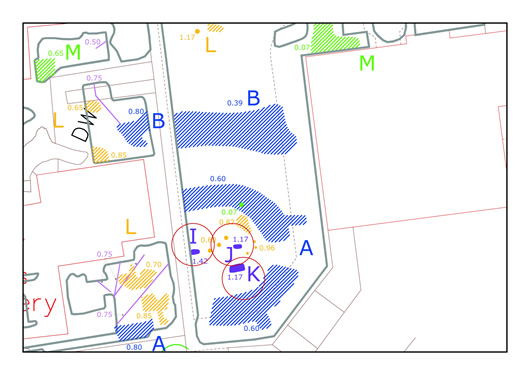As its name suggests, the Hidden Abbey Project is a research initiative to uncover the hidden story of Reading Abbey. The project began with a Ground Penetrating Radar survey of the Abbey Church site (completed in June 2016), to be followed by archaeological investigation. If the location of the burial place of Henry I is located during this time the aim is to place a memorial above ground so that Henry is no longer England’s forgotten king. A nineteenth century tradition from an archaeological paper records how the king’s grave was desecrated in 1550 during the reign of Edward VI (1547-1553) and latter stages of the Dissolution of the Monasteries. At this time, the Norman king’s burial was apparently looted for its purported silver lined coffin. Whether this event took place is, of course, unknown. As a result, it forms one of the project’s many research questions. If the king’s grave is discovered to have been desecrated and his remains scattered it is hoped Henry may be afforded an honourable reburial in nearby St James Church. It is also hoped that any other remains discovered in a similar manner might receive the same.
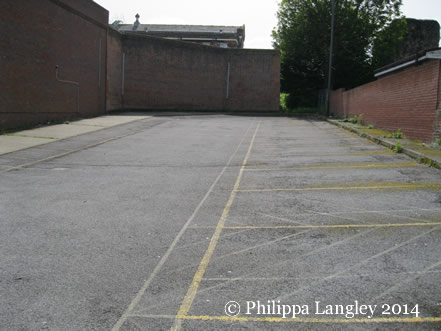
Prison car park located at the east end of Reading Abbey church
‘K’ for ‘King’
We know from the historic record that Henry I was buried in front of the (original) High Altar at Reading Abbey, with Constance of York buried beside him. Both would have been stone sarcophagus burials. The Ground Penetrating Radar (GPR) survey has revealed what looks to be two sarcophagus burials before the (original) High Altar, (‘J’ and ‘K’)1. If burials these would be located at the most eastern end of the abbey and represent very high status burials. Whether these are the burials of Henry I and Constance of York naturally forms one of the many research questions for the Hidden Abbey Project. That is: is it a case of Occam’s Razor and science pointing our way to the king’s burial location in the car park, or are there more evidences to consider and the king’s grave is in the adjacent nursery school site (as many historians believe) and/or lost. From various reading of materials and recent experiences, it seems that the High Altar may have been moved further west within the abbey church at a later date whether to form the ambulatory or perhaps construct the Lady Chapel. Moreover, above ground church rituals and furniture do not always follow (directly) what is below ground. As a result, the science and Occam’s Razor theory as presented here within the GPR survey represents a powerful argument for the location of the king’s grave. It is therefore my contention that not only do we have another king in a car park in Reading, but that ‘K’ is for ‘King’.
The Diocese of Portsmouth has suggested a memorial garden to mark the king’s burial in the car park (should it be uncovered in this location). As the landowner of the adjacent nursery school site the Diocese has also confirmed their view that it would be open to proposals for archaeological excavation on their land but believes the king’s remains are outside of its boundary (see 12 September 2020 below). This seems to confirm that the Diocese also believes the king’s grave is in the former prison car park.
Faversham Abbey was founded in 1148 by King Stephen and Matilda of Boulogne. Both were buried before the High Altar. Please see image. With thanks to Jacob Newbury for bringing Faversham Abbey to our attention. The Faversham plan comes from the 1965 archaeological excavation at the abbey led by Brian Phelp.
1. Tewkesbury Abbey in Gloucestershire with its Norman church plan is a useful comparator for the original placement of the High Altar at the far eastern end of the abbey church. Tewkesbury was funded by King Henry’s (illegitimate) son Robert, 1st Earl of Gloucester (c.1090-1147) and consecrated in 1121, the same year as the founding of Reading Abbey as a priory. It is therefore directly contemporaneous with Reading. However, unlike the great (royal) abbey at Reading, Tewkesbury had to be extended in the early medieval period to form an ambulatory. The only known extension to Reading Abbey was the Lady Chapel in the fourteenth century. The GPR survey therefore seems to reveal the inner construction of the (original) east end of the abbey church.
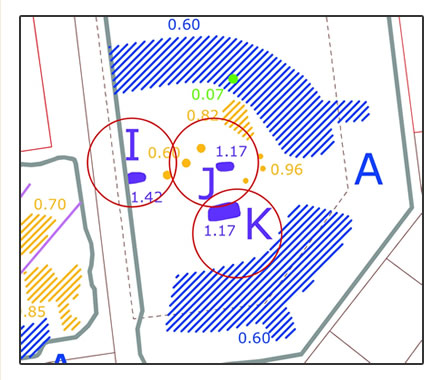
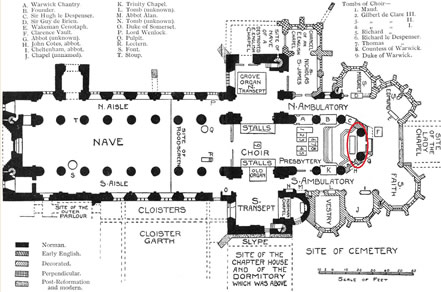
Tewkesbury Abbey Plan with Norman High Altar. Norman Church outline in black.
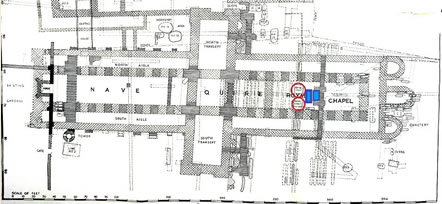
Faversham Abbey and Royal Vaults before the High Altar. Original image of plan: Urbanistic.
Archaeological Excavation
‘The cost for the archaeological excavation of the car park is c.£55k which seems to be a remarkably small outlay to enable Reading to tell its royal story. The cost for the excavation in Leicester was £35k.’
Historic UK, 18 September 2020
Momentum has naturally stalled for the project through a number of unforeseen events, both national and international: the General Election (and subsequent changes in key government ministers), Brexit, the sale of Reading Prison by the Ministry of Justice and now Covid-19. However, as we now understand that Reading was founded as an abbey in 1123 (being a priory before this date) we are hopeful that an excavation might take place before this significant 900th anniversary. More importantly, we also have a powerful local voice in Matt Rodda MP who recognises the potential of the project for Reading, with a local voice desperately needed. Full excavation of the car park location is recommended by the recent MOLA archaeological report of November 2019, and English Heritage/Historic England has previously confirmed that archaeology on the abbey church site is required in order to fully understand it, following the results of the Ground Penetrating Radar survey. The GPR survey was completed in 2016. Historic England has also confirmed that it would be happy to enter discussions for archaeological investigation (see 12 September 2020 below).
The Hidden Abbey Project requires the permission of the landowner and council, with the council confirming that any development of the former Prison site would naturally require planning permission. This would be considered on the basis that full archaeological excavation of the car park takes place, as recommended by the MOLA report (as above).
The cost for the archaeological excavation of the car park is c.£55k which seems to be a remarkably small outlay to enable Reading to tell its royal story. The cost for the excavation in Leicester was £35k. Channel 4 has agreed £10k in funding towards the archaeological phase of the investigations for the Hidden Abbey Project in Reading (see 19 August 2019 below).
Author and historian, Earl Spencer, has confirmed that crowdfunding can finance excavations to recover King Henry's remains. The earl is a distant relative of the Norman monarch (see 12 September 2020 below).
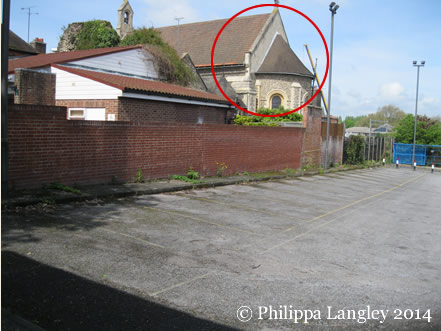
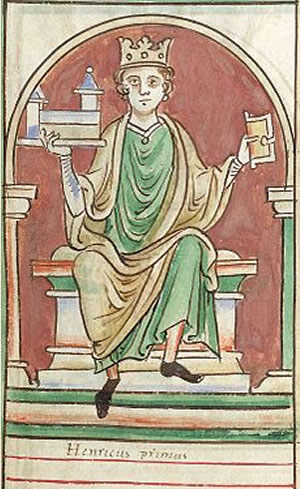
Reburial – St James Church, Reading
There are a number of reasons why St James Church has been proposed by HAP for any potential reburial (if the king’s grave is found to be desecrated, as above). Firstly, it’s important to remember that Henry chose to be buried in this location and built the abbey as his mausoleum. St James is only a few feet from the car park and abbey church site (please see image above), and if it is decided that the Norman king should receive some form of tomb monument there is space for this within St James. St James Church is also of the king’s faith.
Westminster Abbey has also been proposed and is, of course, where so many of our monarchs are buried. However, we know from consultation with the previous dean for the Looking For Richard Project that the abbey is full and Henry would be unable to receive a tomb monument if reburied here. He would, however, be able to receive a brass plaque somewhere in the floor. Perhaps, therefore, taking on board all the above, the king’s own wishes for his burial location should be uppermost in our minds in this regard.
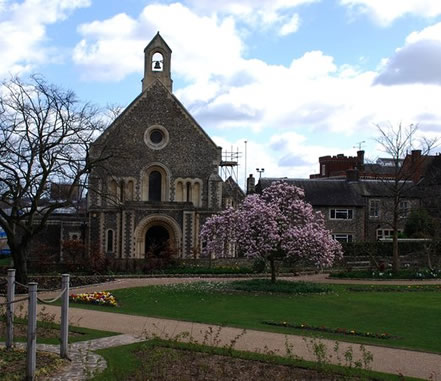
St James Church, Reading. Architect: Augustus Welby Northmore Pugin (1812-1852).
In the autumn of 2013, the people of Reading asked Philippa Langley to initiate a new research project for them so that Reading’s royal story could be told. With key members of the project team in Reading, Philippa is fighting to keep that promise.
Philippa Langley is the originator of the Hidden Abbey Project.
Updates
Update 28 October 2024 – Gaol to become hotel, museum & art gallery
The new owner of Reading Gaol, Channing Bi, has announced today that the Grade II Listed former gaol is to become an hotel, museum and art gallery. There are no plans for flats. Investing £100 million into the former famous gaol site and building Mr Bi believed the hotel might be open in two years, should all Planning Permission and Consents be granted by Reading Borough Council. It is hoped the planning consent will include archaeological exploration of the gaol's western car park and location of the burial place of Henry I of England. See above for the 2016 Ground Penetrating Radar survey results and possible destruction of the king's stone sarcophagus coffin (with lead interior). For more on today's exciting announcement, see here.
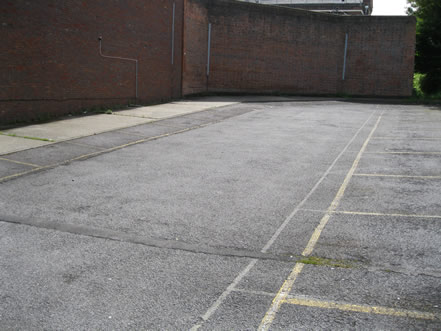
East end of Reading Abbey. Burial place of Henry I. Image: Philippa Langley (2014).
Update 13 January 2024 – Reading Gaol Sold to Ziran (Ireland)
The Ministry of Justice has announced the sale of Reading Gaol to Ziran Education Foundation (Ireland) for £7 million. It is said that 'the proposed plans for the site included an educational centre incorporating a museum and exhibition space.' With Reading Borough Council yet to receive notification of the company's development plans, local MP Matt Rodda is being 'cautiously optimistic'. You can read more here.
Update 29 September 2023 – HAP Meeting with Matt Rodda MP
After a long hiatus the Hidden Abbey Project team met again in Reading with Mayor, Tony Page, leading local historians and researchers, a representative from the Friends of Reading Abbey (FORA) and Reading East MP Matt Rodda.
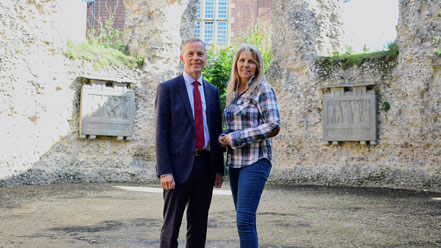
Philippa and Matt Rodda MP at the Abbey ruins with Reading Gaol immediately behind (29 September 2023, image: Nick Hatton)
Update 24 August 2023 – Matt Rodda MP meets Damian Hinds, Prisons Minister
Following Matt Rodda's speech in Parliament, he has met with Damian Hinds, Prisons Minster, to discuss the future of Reading Gaol in order to save the historic Grade II listed building for the local community and for it not to be developed into flats.
Update June 2023 – Reading Gaol Future raised in Parliament
Matt Rodda MP for Reading East spoke in Parliament concerning the future of Reading Gaol and reaffirming the town's wish to preserve the historic building for the local community. Matt Rodda said: “I would like to address my remarks to the question of the future of Reading gaol, which is a Grade II listed building. Locally, we would like to see this historic building reused as an arts and heritage hub and preserved for the community, possibly with some support from outside benefactors.” As a result of Mr Rodda's speech in Parliament, Damian Hinds, the Prisons Minister, agreed to another meeting.
Update 25 March 2023 – Hundreds Walk for Reading Gaol
Today the Save Reading Gaol campaign organised a mass walk in Reading to impress upon the Ministry of Justice just how important Reading Gaol is for the people of the town. Taking part in the walk were MPs, local arts groups, council officials and hundreds of members of the public. The aim is to transform the gaol into an arts and heritage centre and has the backing of leading names in the UK arts world. The march concluded with speeches in the Abbey ruins. You can watch ITV’s Meridian’s coverage of the march here.
Update 12 January 2022 – Two New Artworks On Reading Gaol Wall
In a further twist to the tale at Reading Gaol, another two Banksy-style graffiti artworks have been painted onto the prison walls of the Grade II listed building. The artwork by Peachy showing a man in overalls has since been removed but the artwork revealed just before Christmas by Portus Abonae of Oscar Wilde reading a book has been kept. Abonae has backed the £10m bid by Banksy to turn the prison into an arts hub. Accompanying the figure on the wall is an excerpt from the poem ‘The Ballad of Reading Gaol’ by Oscar Wilde. It reads: “I never saw a man who looked // with such a wistful eye // upon that little tent of blue // which prisoners call the sky”.

Update 5 December 2021 – Banksy Offers £10 Million to Save Reading Gaol!
In the most remarkable development in the long-running campaign to save Reading gaol, world-renowned graffiti artist Banksy has offered a staggering £10 million to ensure the famous gaol becomes the arts centre for Reading as planned. This will allow the local community and Reading Borough Council to purchase the prison that once held Oscar Wilde. Banksy said, “Oscar Wilde is the patron saint of smashing two contrasting ideas together to create magic. Converting the place that destroyed him into a refuge for art feels so perfect we have to do it.” Matt Rodda MP for Reading East who has been spearheading the campaign to save the gaol said, “Following the announcement I am now calling for the Ministry of Justice to completely rethink its approach and for the Ministry to work with the arts community, me and Reading Borough Council. I believe we now have a real opportunity to save this unique historic building for the nation – creating an arts and heritage hub which will be an enormous asset to Reading and the country as a whole.” This is the most extraordinary development and bar anything untoward happening surely means that Reading gaol is now saved!
Saving the gaol may also mean that the Hidden Abbey Project and search for the final resting place of King Henry I can finally begin. We might even be able to discover whether ‘K’ really is for ‘King’ (as above). More importantly, the overlooked town of Reading can perhaps now look forward to a bright new future as ‘Royal Reading’.
Image: Stencil used by Banksy to make ‘Create Escape’ on the walls of Reading Prison. The stencil was exhibited at Bristol Museum and Art Gallery earlier this month as part of an exhibition by the artist Grayson Perry for his Channel 4 series Grayson’s Art Club.

Update 5 December 2021 – Januszczak Asks If MoJ Will ‘do the right thing – the royal thing’
Leading art critic, Waldemar Januszczak has asked if the Ministry of Justice will ‘do the right thing – the royal thing - and finally agree to giving Reading the arts centre it so blatantly deserves?’ Writing in the Sunday Times Culture magazine (pp.18-19), Januszczak was investigating the identity of the mystery donor, and heard three names: the Duchess of Cambridge, comedian Ricky Gervais (both born in Reading), or Banksy, ‘the outlaw graffiti artist, who had already done his bit for the arts centre cause by scaling the walls and painting a prisoner escaping down a knotted sheet holding a typewriter.’ The art critic also reported that rumours for the Duchess of Cambridge being the mystery donor were ‘prompted by the historic connections that bind Reading to the royal family. Henry I, son of William the Conqueror, is buried underneath Reading jail.’

Update 3 December 2021 – Mystery Donor Offers £2 Million to Save Prison
A mystery donor from within the arts world has offered £2 million to boost Reading Borough Council’s bid to save historic Reading Gaol from commercial development. The additional £2 million now boosts the council’s bid for the gaol to £4.6 million. MP for Reading East, Matt Rodda, believes that this ‘offers the government a fair value for the site – and will save it for arts and heritage use.’ Despite the long-running campaign to save the gaol, the Ministry of Justice (MoJ) is still considering bids from commercial developers. As a result, Matt Rodda has now written to Victoria Atkins, the Minister of State within the MoJ, to help save the gaol. You can read Matt’s letter here.
Update 18 November 2021 – Mystery Donors Could Pledge Millions for Prison
Mystery figures from within the art world are offering to help top up Reading Borough Council’s bid in order to save historic Reading Gaol. The financial support could give campaigners a chance to persuade the Ministry of Justice to sell the gaol to the council so that it can become an arts hub, as the Ministry is under pressure to sell to the highest bidder. Leading campaigner for the gaol, Matt Rodda MP, confirmed that it was an important step, which could allow a similar amount of money to be put forward to buy the gaol as a developer may offer. The MP for Reading East was not able to disclose the identity or identities of the people involved but confirmed he has discussed it with Ministers and received a positive response. In addition, he has also written to them. This exciting development reveals the strength of local feeling to save the historic site as a community centre and arts hub. The purchase by the Council, the lead partner in the Hidden Abbey (archaeological) Project, would also finally offer Reading the opportunity to tell its remarkable royal story with Henry I and Reading Abbey.
Update 18 May 2021 – Council’s £2.6 Million Bid for Prison Rejected
Reading Borough Council’s bid to buy its famous Grade II listed Prison and convert it into an arts hub has been rejected by the Ministry of Justice for being too low. The council and local MP Matt Rodda have now requested urgent talks with the Secretary of State and Justice Secretary. Cllr Tony Page said: “This is now the second time the MoJ has rejected a community bid for the empty site. It would be a real setback if, for a second time, the MoJ were to place Reading Gaol on the open market. It is now nearly eight years since the MoJ’s process began, and all that time the gaol has laid empty.”
Update 10 March 2021 – Council Submits Bid For Prison
Last night Reading Borough Council gave its official seal of approval for a new bid to the Ministry of Justice for the iconic landmark site of Reading Gaol. If the bid is successful, the Council will seek a private sector partner to undertake a comprehensive regeneration, and set up a cross party Reading Goal board. Council Leader Jason Brock said: “This is a once in a lifetime opportunity to deliver a unique culture and heritage hub for Reading. We firmly believe a successful bid by the Council would be a game changer. A catalyst for further investment in Reading, a key driver in our recovery from Covid and the creation of a site of local, regional and national significance in the heart of our town and in our historic Abbey Quarter.” Here’s hoping a successful bid will also act as the driver and catalyst for the search for another king in a car park, and herald the start of a bright new future for ‘Royal Reading’.
Update 15 December 2020 – Spooks Actor Joins Call to Save Prison
Spooks and Star Trek: Discovery actor Shazad Latif, has joined the campaign to save Reading Gaol and turn it into a local arts and heritage site. Shazad joins a number of leading actors in the fight to save the goal. These include Dame Judy Dench, Sir Kenneth Branagh, Nathalie Dormer and Stephen Fry.
Update 1 March 2021 – New Banksy Artwork Could Save Prison
A stunning new artwork has appeared overnight on the wall of Reading Prison just as the fight to save the prison as an arts and heritage centre is underway. Believed by an expert to be a new Banksy this could be a game-changer for the future of the prison. Vince John, from the 1loveart gallery in Bristol, which sells urban and street art, said: "I believe this is an example of Banksy's street work at its best, being both humorous and politically poignant. A great piece of work and a brilliant social commentary." The art curator said he thought it referenced Oscar Wilde and could be a "nod of encouragement for the use of the building as a cultural and arts centre... now it has its crowd-puller and star exhibit to get things moving in the right direction". Read more here.

Update 15 December 2020 – Spooks Actor Joins Call to Save Prison
Spooks and Star Trek: Discovery actor Shazad Latif, has joined the campaign to save Reading Gaol and turn it into a local arts and heritage site. Shazad joins a number of leading actors in the fight to save the goal. These include Dame Judy Dench, Sir Kenneth Branagh, Nathalie Dormer and Stephen Fry.
Update 4 December 2020 – Leading Actors Join Call to Save Prison
Leading actor Sir Kenneth Branagh and Game of Thrones star Nathalie Dormer join Dame Judy Dench and Stephen Fry in the campaign to save Reading Gaol as an arts and heritage centre. Nathalie was born in Reading and attended Reading Blue Coat School. Local MP Matt Rodda who is spearheading the campaign said, “It is significant that the campaign has growing support from leading actors. I hope the MoJ will listen and change its approach.”
Update 1 December 2020 – Dame Judy Dench Joins Call to Save Prison
Oscar winning actress Dame Judy Dench has joined the local campaign to save Reading Gaol as an arts and heritage centre. Dame Judy joins Stephen Fry in support of the campaign. The campaign was begun by local MP for Reading East, Matt Rodda, and is also supported by the Reading Chronicle. Dame Judy said that turning the Reading Gaol into a “cultural and artistic centre” would be a “great gift” for Reading, the UK and the world.
Update 19 November 2020 – Sale of Reading Prison Falls Through
The Ministry of Justice deal to sell Reading Gaol to the highest bidder for housing and a luxury hotel has fallen through. Planet Radio in Berkshire reported: ‘Reading Borough Council who had been leading a bid to keep the prison as a community arts centre say they'll now seek urgent talks to revive their plans.’ Tony Page, Deputy Leader of the council who wants to work in partnership with the MoJ said: "What will secure this site is heavy footfall through a range of diverse uses on the site and not a single use. That is the mistake the MOJ (Ministry of Justice) is making... I think there are major opportunities we can unlock if we adopt that approach." Reading East MP Matt Rodda added: "My first step (since hearing of the collapse of the sale) has been to write to the Prisons minister asking her to look again at the whole project. It's clear the Government can't sell the prison to a commercial bidder and that means they should look again at arts and heritage uses. I've also written to the chair of the commons culture media and sport select committee to ask for his help, he's offered support in the past." We can only hope that the MoJ is listening.
Update 30 September 2020 – Julian Knight MP, supports Campaign to Save Gaol
Matt Rodda has announced the support of Julian Knight MP, the Chair of the Select Committee for Culture Media and Sport, for the campaign to save Reading Gaol. Julian has written to the Prisons Minister calling for the historic site to be saved for the benefit of the community in Reading as an Arts Centre. Being ‘not only the site where Oscar Wilde was once imprisoned, but also being built on the former Reading Abbey and home to the remains of King Henry I’ Julian added that ‘Britain has a proud tradition of preserving heritage sites ... that are also assets which draw tourists to their local communities, generating and driving local tourist spend.’ You can read Julian’s letter here.
Update 18 September 2020 – Philippa Langley reveals ‘K’ for ‘King’ in Reading Car Park
Historic UK has revealed Philippa Langley’s research into the layout of Norman churches which suggests Reading does indeed have another king in a car park. The results of the Ground Penetrating Survey of the former Reading Prison car park reveals what seems to be two sarcophagus (stone) burials. Langley’s analysis of the location of the High Altar in Norman churches suggests that one of these is the burial of King Henry I, and ‘K’ is for ‘King’. Historic UK added that the king’s burial was thought to be under an adjacent nursery school which is ‘the location favoured by historians’. So is this the location of the king’s grave. This mystery forms one of the many research questions for the Hidden Abbey Project. Historic UK revealed, ‘Costs for the car park archaeology are projected at c.£55k. The cost of the archaeology that found the king in the car park in Leicester was £35k.’ It is hoped archaeology will begin as part of Reading Borough Council’s planning permission for the development of the Prison site by the new owner. The council is the Lead Partner in the Hidden Abbey Project. ‘Local MP, Matt Rodda, is also championing the project.’ To read more please visit Historic UK here.
Update 12 September 2020 – Earl Spencer Hopes Crowdfunding Can Finance Search for King
The Times newspaper has revealed that Earl Spencer, brother of Princes Diana, ‘hopes that crowdfunding can finance excavations to recover the remains’ of King Henry I in Reading. The earl is publishing a new book on the king. The newspaper reported: ‘A distant relative of Henry I, Charles Spencer, the 9th Earl of Spencer, has started a campaign to exhume his remains in Reading to give them a “dignified reburial” in a church.’ The report also confirmed that the Catholic Diocese of Portsmouth, which owns the nursery school land said ‘it would be open to proposals’ for archaeological excavation ‘but believed that the remains [of the king] were outside its boundary.’ The car park is directly adjacent to the nursery school site. Historic England, who oversee the abbey site as a Scheduled Monument, has also confirmed that ‘it would be happy to enter discussions’ for archaeological investigations.
Update 30 April 2020 – Matt Rodda MP Writes to Prisons Minister
Matt Rodda MP has written to Prisons Minster Lucy Frazer MP to reconsider the departments recent decision to award Reading Gaol to a commercial developer. The prospect of this internationally famous and historically important building, where Oscar Wilde was imprisoned and wrote his Ballad, becoming a hotel or flats is raising grave concerns. Matt says: The campaign to save Reading Gaol ‘has also been supported by the Oscar Wilde Society, the actor Stephen Fry and a wide range of arts, heritage and community groups, including a number of LGBT community organisations. The Irish Government has also expressed an interest in preserving the gaol, as an important cultural and literary site because of Oscar Wilde and the links to Ireland.’ Matt has also raised the importance of the current economic situation, adding: ‘The current preferred bidder could face significant difficulties paying for the site and financing the proposed development, which could leave the Department unable to sell the site, or struggling to complete the sale. Even if a bidder bought the site, any development could be difficult to finance and build.’ Matt says: ‘Given the unique nature of the site and the significant level of support together with the unprecedented economic situation caused by the pandemic, I hope you will agree that there is a strong case for a review of the Department’s earlier decision... and for the historic building and the site as a whole to be preserved for the community.’ We can only hope that urgent consideration will be given to Matt’s important letter.
Update 9 April 2020 – MP Urges Government to Think Again
In a message from Matt Rodda MP, it is confirmed that the Ministry of Justice has chosen a commercial developer as its preferred bidder to negotiate with as it sells Reading’s famous gaol and landmark. Matt is concerned about this development and is urging the Government to think again, asking Ministers to reconsider the option of arts and heritage use and to look again at the Council’s bid. Deeply disappointed with the Government’s approach, Matt is calling on Ministers to work with the Council and to respect the enormous historical importance of the gaol, including the link to Oscar Wilde and the remains of Reading Abbey, part of which are under the prison site. We can only hope that Matt is successful so that Reading can tell its remarkable story with its twelfth century Abbey and its founder, King Henry I of England.
Update 7 April 2020 – Council Bid for Reading Gaol Rejected
Reading Borough Council has expressed its disappointment that its bid to purchase Reading Prison has been rejected by the Ministry of Justice. The Council has vowed to work with the successful bidder to ensure its huge historical and cultural value is recognised in any future development. Local Planning policies mean it is essential that any proposed future development of the site has provision of a cultural or historical element which draws on the significance of the Reading Prison site. Importantly, for the Hidden Abbey Project, the Council has also confirmed that it is highly likely that further archaeological assessments and investigations will be needed to inform any future development through its Planning parameters.
Update 15 March 2020 – Stephen Fry Joins Call to Save Famous Landmark
Actor Stephen Fry and novelist Julian Barnes have become the latest supporters of the campaign to turn Reading Gaol into an arts and heritage site, amid fears the famous landmark could be converted into a block of flats.
Update November 2019 – Council To Bid For Famous Gaol
At a meeting of Reading Borough Council’s Policy Committee on 19 November it was announced that the Council will place a bid for its famous landmark, Reading Gaol, to save it for the town and community. The aim is for the historic Grade II Listed building in the Abbey Quarter to become a theatre, arts hub and cultural centre.
Update November 2019 – MOLA Archaeological Report
Museum of London Archaeology (MOLA) has published its archaeological report for the East End and Lady Chapel of Reading Abbey on the site of Reading Gaol. The East End of the abbey church is located in the gaol’s western car park and is the likely location of Henry I’s burial. The report recommends extensive archaeological investigation prior to any development of the site. The report is not yet publicly available.
Update October 2019 – Public Support For Campaign
Reading came out in support of MP Matt Rodda’s campaign to save the town’s famous landmark. Residents gave a hug in support of plans for the gaol to house a new theatre and arts centre. Campaigners have called on the Ministry of Justice to stop the empty prison site from being sold to the highest bidder for housing.
Update October 2019 – Reading Gaol For Sale
The Ministry of Justice has put Reading Gaol up for sale. As the gaol’s western car park contains the important East End of the abbey church (and likely location of Henry I’s burial place) the sale is a significant move for the future of the Hidden Abbey Project and its proposed archaeological investigation to uncover the lost abbey church. Archaeological investigations on the heritage site would require the landowner’s permission.
Update August 2019 – British Archaeology Magazine
The July/August issue of British Archaeology magazine published an important article that raised the issue of the refusal of the Ministry of Justice to publish the recent MOLA investigations, and with calls for a properly resourced public research project to be implemented. It is hoped this might fund the research of the Hidden Abbey Project.
Sadly a second article by Mike Pitts makes a number of inaccurate assertions about the Hidden Abbey Project.1 The project has received £10k of funding for the archaeological phase of its investigations (with the car park archaeology likely costing c. £55k); the research project is not being done for personal profit or gain; and no archaeologists have signed, or been asked to sign, confidentiality contracts.
1. In 2015 a 24 page document was sent to Mr Pitts detailing the inaccuracies, omissions and misinformation in his writings about the search for Richard III. Sadly at this time he also changed published quotes and failed to check his facts with any members of the Looking For Richard Project team.
Update July 2019 – Petition Reaches 7000 Signatures
The petition by Matt Rodda MP to save Reading Gaol has received over 7000 signatures. You can sign Matt’s petition here.
Update May 2019 – Calls For Gaol To Be Saved
MP for Reading East, Matt Rodda, is leading the calls for Reading Gaol to be saved and turned into an arts hub and theatre to commemorate Oscar Wilde and other significant historic events. The Prison car park is believed to contain the burial place of King Henry I of England who founded the Abbey. The site has a number of important historical links including being the location where King Edward IV of England (1442-1483) announced his secret marriage to Elizabeth Woodville. The union was responsible for the demise of the Plantagenet and Yorkist dynasties. You can sign Matt’s petition to save Reading Gaol here.
Update June 2018 – Reading Abbey Ruins Re-Open
Following a £3.15 million conservation project, the ruins of Reading Abbey are open again to the public. The ruins were closed for nine years due to safety concerns. The painstaking conservation work took three years to complete. Congratulations to Reading Borough Council and Museum. The ruins are now open daily from 8am-6pm.
Update October 2016 – Archaeology at Reading Gaol
Museum of London Archaeology (MOLA) have begun an archaeological investigation of Reading Gaol. A number of trenches will explore the archaeological potential of the Scheduled Ancient Monument site prior to its proposed sale by the Ministry of Justice. It is understood investigations will include the East End of the Abbey Church in the gaol’s western car park and likely location of the burial place of King Henry I.
Update October 2016 - GPR Results In
Results of the Ground Penetrating Radar Survey are now in. To get right up-to-date with this exciting new research initiative, you can read Philippa’s interview with the BBC History magazine here.
Update June 2016 - GPR Survey Begins
The first phase and Ground Penetrating Radar (GPR) survey was given the green light by the Hidden Abbey Project Steering Group, and its Lead Partner, Reading Borough Council. Undertaking the survey was Stratascan who had led the investigations in Leicester in the summer of 2011.
The Hidden Abbey Project - Background:
Helping Others
In the autumn of 2013 as Philippa travelled the country to tell the story of her discovery of the grave of King Richard III in a council car park in Leicester, the interest in her nearly 8 year research project was overwhelming. The Looking For Richard Project had captured the public’s imagination and succeeded in bringing Richard III to the attention of a global audience. The project had also succeeded in removing many of the myths surrounding this monarch, not least the well-established story of his remains being thrown into the River Soar.
As Philippa's lecture tour took her through the Thames valley, many people from Reading approached her to see if she could help. Their town had a story to tell and an unfinished history. Residents of this often overlooked commercial hub wanted to tell its historical story.
Philippa's Story
I had first visited Reading in 2005 when a friend moved to nearby Oxfordshire and suggested a trip to the retail hub. With my expectations for a pretty ordinary shopping trip, my girlfriend knew exactly what she was doing. Knowing my passion for history we entered the town, and turned a corner. I saw the Abbey Quarter and its gardens for the first time. They took my breath away. As we walked the ancient ruins and delved into its past, visiting the gardens and the beautiful (Pugin) St James’s Church, we spent the day exploring its story. With all my preconceptions about Reading – the commercial hub - now firmly set aside I left with an overwhelming sense that it was an historic town that held a hidden gem in its abbey, and the story of a forgotten king in the abbey’s founder, Henry I.
Sadly, a few years later, the ruins of Reading Abbey were closed as the state of deterioration had made them unsafe for visitors. That, it seemed, was that but as Reading Borough Council now fought to secure a grant from the Heritage Lottery Fund to restore and re-open the ruins, and with this persuasive request from the residents of Reading, I now needed to know; was its story really worth the telling?
Reading's story: The Abbey
Unlike Leicester where King Richard had been buried in a small friary church of little note, here Henry I had been laid to rest with all pomp and ceremony in the magnificent abbey he had founded as a palace and royal mausoleum.
Consecrated in 1164 by Thomas Beckett, the abbey quickly established itself as a leading place of Pilgrimage and a religious powerhouse, making Reading one of medieval England’s most important towns. Reputedly of a basilica style construction almost the size of (medieval) St Paul’s, the abbey would become one of the richest in England.
Research now suggested that beneath the ground lay the remnants of this Cluniac Norman Abbey and royal palace which, unlike other great abbeys and cathedrals, had not been significantly added to, with the only known addition being a Lady Chapel in 1314.
Could a research project bring this important, and potentially unique, Romanesque structure back to life, and what stories could it then tell us about its construction, architecture and royal founder, King Henry I of England who had been buried before its High Altar?
King Henry I of England (1068-1135):
And what of Henry himself, did he also have a story to tell? Henry I is our forgotten king, his thirty-five-year reign falling between that of his famous father, William the Bastard (Conqueror), and the period of unrivalled bloodletting known as The Anarchy in the time of his daughter, Matilda. Henry’s story, however, is yet to be told. A controversial monarch, his narrative has many similarities to that of Richard III, being a youngest son who rose to become king and who lost his queen, and son and heir in tragic circumstances, throwing the country into a succession crisis. However, despite having bastard sons a plenty, in an unprecedented move, Henry named his daughter Matilda his heir in apparent recognition of her status and equality. Known variously as Henry Beauclerc and the Lion of Justice, in these violent times Henry could be a harsh ruler but he also formalised our legal system, introduced the modern Royal Exchequer and supported the first-ever royal meritocracy in the rise of talented low-born individuals through his appointments of courtly administrators. At the age of sixty seven Henry died in France after reportedly eating a surfeit of lampreys and was the first monarch to be embalmed so that his body could be transported back to Reading for burial, sewn into a bull’s hide. Burial in his abbey at Reading had been the king’s wish. He was also the only King of England known to have killed someone when dead. Intrigued by his story? Yes, I was too.
It seemed the people were right; Reading did have a fascinating and unique story to tell. Leaving her autumn 2013 lecture tour, Philippa headed back to Reading to see for herself the closed ruins of the once great abbey.
Inauspicious Beginnings
In late November 2013 a fact-finding visit and meeting at Reading Museum augured well. By January 2014, the Director of Communications at Reading Borough Council supported the new project and agreed that following the success of Leicester’s story with King Richard, it was time for Reading to tell its own royal story with King Henry and his magnificent abbey. Sadly, with the Head of Communications having left the council, the project stalled but undeterred another meeting was arranged for the end of April. Accompanying Philippa for the meeting was trained archaeologist, Simon Young, a leading producer and documentary filmmaker from Darlow Smithson Productions. New faces, same pitch, but the response was now muted and sceptical.
Any potential research project to bring Reading’s abbey and historical story to life would be insurmountable. Three key landowners would have to be convinced and agree access, and as a Scheduled Ancient Monument (SAM) site, Historic England (formerly English Heritage) would also have to recognise the project’s potential to secure the necessary permissions and any form of green light. Specialist advice locally suggested that there was not much point in going any further as these permissions were not likely to be forthcoming and there was nothing new to be discovered, no new stories to tell. However, it was now clear that Reading had an important story to tell and that the potential to learn more about this little-known royal abbey was a significant opportunity. Even if nothing new was found, that nothing would still move our knowledge forward and help confirm, at the very least, the most recent thinking. It wasn’t time to give up yet. The research looked good and we had a real possibility of bringing the abbey to life through the first modern comprehensive study and non-invasive analysis using Ground Penetrating Radar (GPR).
From such inauspicious beginnings, everything would soon change. One of the residents, who had originally approached Philippa in the autumn of 2013, now gave her the contact details of a respected local historian who had been researching the abbey for many years. Meeting John Mullaney and his researcher wife, Lindsay, they agreed that Reading had a unique story to tell and they too wanted to help make a research project happen. Taking Philippa to meet Father John O’Shea at St James’s Church, and the representative of a key landowner in the Diocese of Portsmouth, Philippa learnt about his interest in its history and wish to know as much as possible about the great abbey, on whose land his beautiful church now stood. This key landowner was now on board. Father John offered his Presbytery for meetings over the coming year to help raise the necessary local interest, with John and Lindsay becoming key to the project’s success. With John and Lyndsay as founder members, the local team began to grow. Darlow Smithson joined a number of meetings as Philippa made it clear that her involvement was to bring the story of Reading Abbey and its founder, King Henry, to light through the proposed documentary, and as promised.



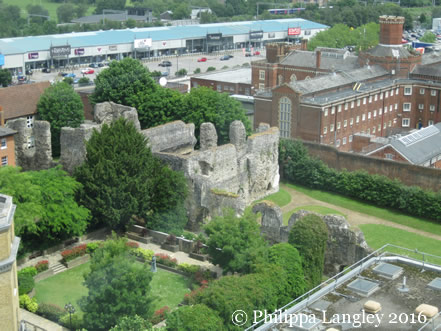
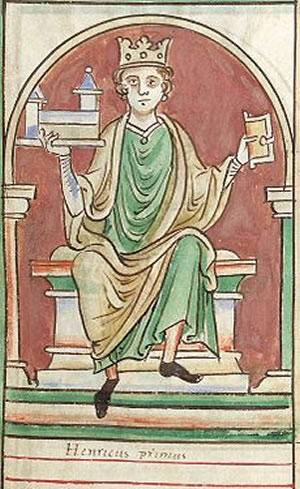
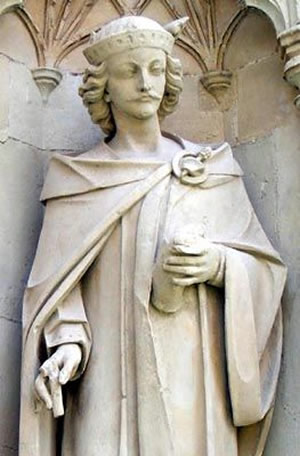

The Hidden Abbey Project
By the late spring of 2014, Philippa officially named the project to clarify its aim, and the first of many tentative meetings for the Hidden Abbey Project (HAP) began. In a few short weeks, HAP found new champions in Councillor Tony Page, Deputy Leader of Reading Borough Council and councillor for the Abbey Ward, and Councillor Sarah Hacker, soon to be Reading’s new mayor who would take the project forward under her leadership and guidance. Reading Borough Council, another key landowner was on board as Philippa now made contact with the Ministry of Justice, owners of Reading Gaol and the last significant landowner, to introduce the project and open negotiations.
By the start of 2015 and having met with Simon Thurley, the CEO of English Heritage (now Historic England) he quickly recognised the project’s potential to raise awareness and regenerate an important SAM site. Simon put Philippa and John and Lindsay in touch with Dr Andrew Brown, Planning Director South East for Historic England in Guildford, the local office with jurisdiction for Reading and its abbey. Andy could also see the potential but was very clear that any research project would be a step-by-step process under their auspices and guidance. The first phase would be the GPR survey of the site of the abbey church building in order to inform and guide later targeted archaeology.
With the Hidden Abbey Project pitched to the award-winning Darlow Smithson Productions, funding for the first phase GPR was secured with the aim of making a documentary film about Reading’s royal abbey for Channel 4.
By the late autumn of 2015 as the Chancellor George Osborne announced the sale of Reading Gaol, the last key landowner, the Ministry of Justice, came on board and the project finally reached critical mass. Two years after the people of Reading had approached Philippa, and with the team in Reading now bringing in the local expertise to guide the research project forward, they would now make this story their own.
In November 2015, Reading Borough Council secured £1.77 million from the Heritage Lottery Fund to restore and reopen the ruins of Reading Abbey through their Reading Abbey Revealed Initiative.
The Hidden Abbey Project gets underway in June 2016, Reading’s Year of Culture, with Phase One, a Ground Penetrating Radar (GPR) survey of the abbey church building. For more information, please visit Reading’s Hidden Abbey blogspot.
Philippa Langley is a writer / producer who led the 2012 search for Richard III through her original Looking For Richard Project. She has originated and facilitated the Hidden Abbey Project for the people and historic town of Reading so that they can now tell its remarkable story.
